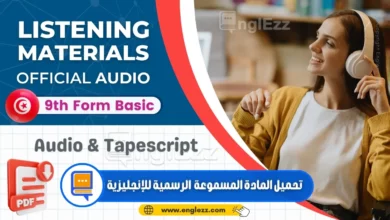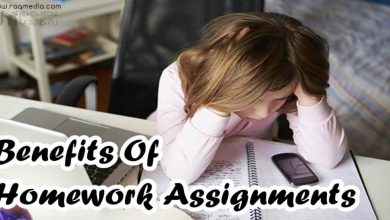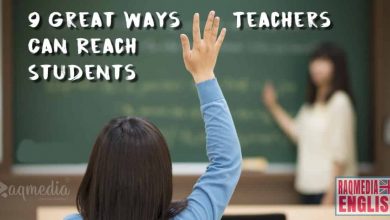I’ve been there. You’re in the middle of a brilliant explanation, the kind of lesson you spent hours planning, and you feel the shift. A pencil drops, a whisper starts, and like a virus, the distraction spreads. Children begin to scatter, their focus dissolving, and a few more seconds will see your carefully structured lesson devolve into total chaos. You feel the heat rise to your cheeks, your throat tightens, and the impulse to raise your voice – to shout over the din – becomes almost overwhelming.
I’ve learned the hard way that this approach is a losing battle. It breaks your spirit, shatters your vocal cords, and models the exact kind of dysregulation you’re trying to prevent. After two decades in the classroom, I can tell you with absolute authority: the solution isn’t to be louder than your students. The solution is to be smarter. It’s about having a toolkit of strategic, practiced, and effective attention-getters that transition students from their world back to yours without a single raised voice. This isn’t just about crowd control; it’s about building a classroom culture of mutual respect and ready-to-learn minds.
The High Cost of “Teacher Voice”: Why Yelling is a Failed Strategy
Before we dive into the solutions, let’s briefly diagnose the problem. When we consistently rely on volume to gain control, we inadvertently teach our students several damaging lessons.
First, we condition them to only respond to escalated noise. They learn that a normal speaking voice is the background, and the real cue to listen is when we’re shouting. This creates a classroom where the baseline volume is perpetually high. Second, it’s physically unsustainable. Vocal strain is a leading cause of teacher burnout and medical leave. Your voice is your primary instrument; protecting it is non-negotiable. Finally, and most importantly, it erodes the trusting, psychologically safe environment we strive to create. A classroom governed by fear of a shouting adult is not a classroom where children feel safe to take academic risks, share ideas, or be themselves.
The alternative requires a shift from reactive to proactive management. The following strategies are not just tricks; they are systems. I’ve curated and refined these through years of trial and error across different grade levels. Their power lies not in their novelty, but in their consistent and intentional application.
10 Effective Battle-Tested Attention Getters for Teachers
The key to success with any of these techniques is the Three P’s: Practice, Procedure, and Praise. You must explicitly teach the signal, practice it repeatedly in calm moments, and consistently praise the class when they execute it well. Do not introduce these in the heat of a meltdown.
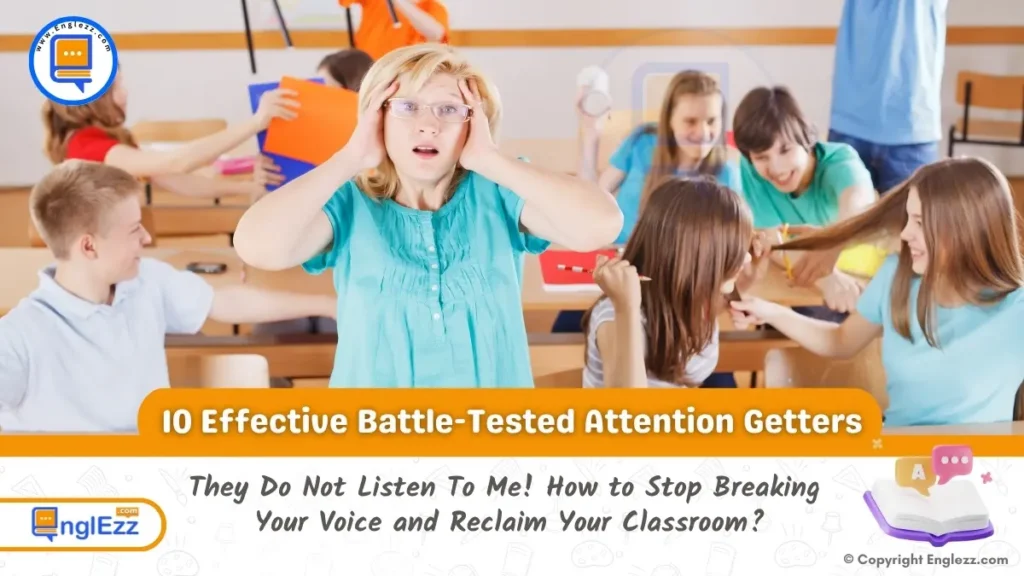
1. The Rhythmic Clap (Clap-Clap, Slap-Slap)
This is a classic for a reason, but its effectiveness hinges on nuance.
- How it Works: Don’t just clap a random pattern. Clap a specific, somewhat complex rhythm (e.g., CLAP-clap-clap-CLAP-CLAP). The students’ job is to stop what they are doing and repeat the rhythm back to you exactly.
- The Pro-Move: Start with loud, clear claps. Once they’ve mastered it, begin to lower the volume with each successive call-and-response. Eventually, you can command the room’s attention with a near-silent clap made only with your index fingers. This builds incredible focus as students have to listen more carefully.
- Why It Works: It’s auditory, kinesthetic, and requires active cognitive processing to decode and replicate the pattern. It’s impossible to do while talking or fidgeting.
2. The Conditional Clap (If You Can Hear Me, Clap Once)
This is a brilliant tool for de-escalating a noisy room without competing with it.
- How it Works: In a calm but firm voice, say, “If you can hear my voice, clap once.” (A few students will clap). “If you can hear my voice, clap twice.” (More students will join). Continue this process, lowering your own volume each time, until the entire class is silently clapping in unison and all eyes are on you.
- The Pro-Move: Use a visual cue alongside the verbal one, like raising a finger for each clap. This supports your auditory learners and draws in students who may not have heard the initial instruction.
- Why It Works: It leverages social conformity and curiosity. Students see their peers engaging in a silent, unified activity and don’t want to be left out. It builds momentum quietly and efficiently.
3. The Volume Knob (Top Top)
This one is fantastic for getting the wiggles and excess energy out in a controlled way.
- How it Works: Tell the class you’re going to turn up the “stomp volume.” As you raise your hand higher, they stomp their feet louder and louder. Then, dramatically, you swiftly lower your hand and bring your finger to your lips for silence.
- The Pro-Move: Frame it as a game. “Let’s see if we can make the floor shake! Ready? My hand is the volume knob!” The controlled chaos is cathartic for them, and the sharp, visual cut-off signal is easy for everyone to see and obey.
- Why It Works: It provides a sanctioned, time-limited outlet for loud, physical behavior. By giving them permission to be loud, you make it easier for them to choose to be quiet when the signal is given.
4. The Kinesthetic Sync (Copy Me)
Sometimes, the brain needs the body to reset. This strategy does exactly that.
- How it Works: Simply say, “Copy my moves.” Start with large, obvious movements (touching your toes, waving arms in a circle). Gradually make the movements smaller and more focused (tapping your nose, wiggling your ears, making a silly face).
- The Pro-Move: The progression is crucial. You are physically bringing their energy level down, step-by-step, from whole-body engagement to fine motor skills. By the end, they are calm, focused, and looking directly at you.
- Why It Works: It forces a cognitive shift from whatever they were doing or thinking about to mirroring your actions. It’s a full-system reset that is both fun and regulating.
5. The Sonic Reset (Yo-Ho-Ho)
A close cousin to the kinesthetic sync, this uses silly sounds instead of movements.
- How it Works: Announce, “My turn, then your turn!” and make a funny sound (e.g., “Yo-ho-ho!”, “Beep-bop-boop!”, a quiet “Zooooom!”). They repeat it. Like the movement version, start with louder, more exuberant sounds and gradually shift to quieter, more focused ones.
- The Pro-Move: Tie the sounds to your current unit of study. Use animal sounds during a biology unit or simple vocabulary words in a foreign language class. This adds a layer of implicit learning.
- Why It Works: It’s playful and disarming. It’s hard to maintain a sour mood or off-task behavior when you’re collectively making dolphin noises. The gradual quieting directly calms the nervous system of the entire room.
6. The Silent Signal (Hands Up)
This is the ultimate test of a well-practiced classroom procedure. Its power is in its silence.
- How it Works: Simply stop what you are doing, and raise your hand high. The procedure is that when a student sees your hand raised, they stop talking and raise their own hand. This visual wave sweeps across the room until everyone is silent with their hand up.
- The Pro-Move: Time it. In the first week of school, I challenge my class: “Let’s see how fast we can get from full noise to full silence with the hand signal.” They love beating their previous record. This turns a management tool into a collective challenge.
- Why It Works: It’s a powerful lesson in non-verbal communication and peer accountability. It fosters a sense of community, as every student becomes a responsible actor in restoring focus.
7. The Thematic Cue (Magic Sign)
Inject a little wonder and engagement by tying your attention signal to your classroom theme or a current topic.
- How it Works: Introduce a “magic sign.” For example, during a space unit, you might say, “Astronauts, prepare for landing!” and they must all pretend to put on a helmet. During a unit on birds, the cue could be, “Flap your wings like a hummingbird!”
- The Pro-Move: Let the students help create the magic signs. This gives them ownership and investment in the process, making them far more likely to engage with enthusiasm.
- Why It Works: It builds classroom identity and makes routine fun. The novelty of a themed signal recaptures wandering attention far more effectively than a generic command.
8. The Auditory Tool (Bell or Timer)
For some teachers and students, a clear, consistent, and neutral sound is the most effective reset button.
- How it Works: This can be a gentle chime, a bell, a rainstick, or even the distinct ding of a timer app on your interactive whiteboard. The rule is simple: when the sound is made, it’s time for voices off and eyes on the speaker.
- The Pro-Move: Use a timer sound specifically to signal the end of collaborative talk time. The sound becomes a predictable and fair cue that helps students manage their own conversations, knowing exactly how much time they have left.
- Why It Works: It’s consistent and emotionally neutral. The sound itself isn’t your voice, so it doesn’t carry the emotional weight of frustration. It’s simply a signal, making it easier for students to comply without feeling chastised.
9. The Collaborative Countdown (5…4…3…2…1)
This technique uses collective voice to build towards silence, creating a shared responsibility for the transition.
- How it Works: Firmly but calmly, start counting backwards from 5. You can use your voice, or simply hold up your fingers. The expectation is that students join you in the countdown, and by the time you reach zero, everyone is silent.
- The Pro-Move: Use a visual countdown on your board for support. For younger students, you can make it a countdown to “blast off” where they all sit down at zero. The key is the unified participation.
- Why It Works: The act of chanting numbers together creates a unified purpose. It’s a clear, time-bound transition that gives students a few seconds to finish a thought or action before the expectation of silence begins.
10. The Regulating Ritual (Massage)
This is my secret weapon for after lunch or recess when brains are tired and bodies are restless. It’s a focus-getter that is also a self-regulation tool.
- How it Works: Simply say, “Time for a brain boost.” Then, silently, start performing a simple, calming action. This could be gently massaging your temples, rubbing your ears (which has proven benefits for alertness), doing finger pulls, or cross-body stretches.
- The Pro-Move: Explain the science! Tell them, “We’re massaging our ears because it sends extra blood to our brains and helps us think more clearly.” When students understand the why, they participate more willingly. They are learning lifelong skills for self-regulation.
- Why It Works: It’s inherently calming. Unlike other strategies that might hype kids up, this one brings the energy level down physically and physiologically. It teaches students to recognize and manage their own state of arousal, a critical executive function skill.
At-a-Glance: Attention-Getters Pros and Cons
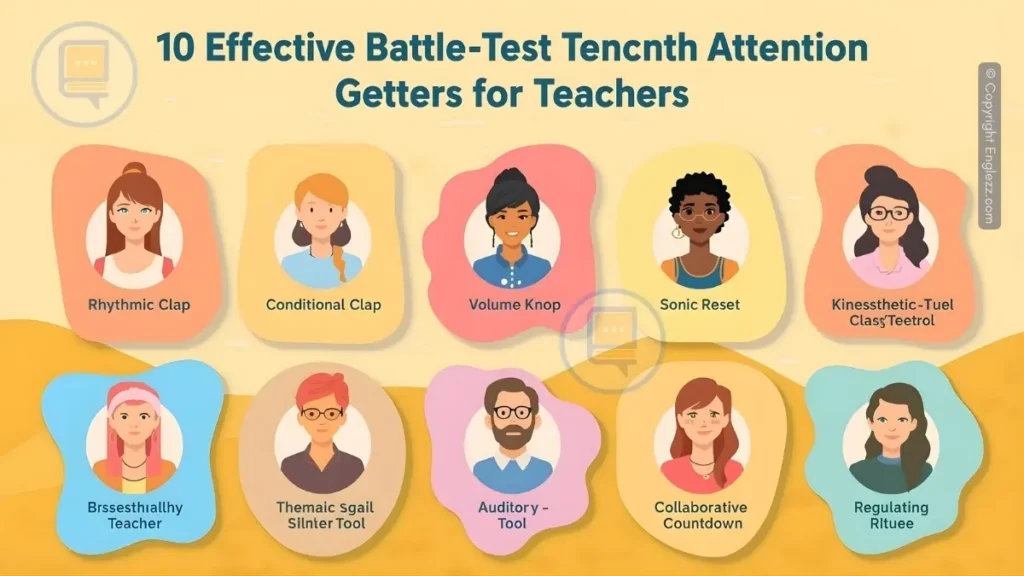
| Method | Pros | Cons / Considerations |
|---|---|---|
| Rhythmic Clap | Engaging, trains focus, quick. | Can add noise, requires practice. |
| Conditional Clap | Great for de-escalation, uses peer influence. | Slower to take effect. |
| Volume Knob | Releases energy, fun, clear visual cue. | Raises energy, can be disruptive. |
| Kinesthetic Sync | Full brain/body reset, regulates energy. | Time-consuming, requires space. |
| Sonic Reset | Playful, cognitive shift, simple. | Risk of over-silliness, adds sound. |
| Silent Signal | Fastest & quietest, builds peer accountability. | Requires strong routine & visual focus. |
| Thematic Cue | High engagement, reinforces content. | Requires creativity and rotation. |
| Auditory Tool | Consistent & emotionally neutral. | Dependent on an object, can be ignored. |
| Collaborative Countdown | Clear time boundary, shared responsibility. | Can feel authoritarian if misused. |
| Regulating Ritual | Calming, teaches self-regulation. | Slow-paced, requires explicit teaching. |
The Foundational Skill: How This All Connects to Teaching Children to Read
You might be wondering what classroom management has to do with the complex cognitive process of learning to read. The connection is everything. A chaotic classroom is a literacy-poor classroom. Phonemic awareness, decoding, and comprehension require immense cognitive focus. You cannot teach a child to decode a digraph if they are distracted by a peer tapping a pencil. You cannot foster a love of reading in an environment filled with auditory clutter.
The attention-getters I’ve outlined are the prerequisite to effective literacy instruction. They create the “sacred space” for reading. When you successfully use a “Magic Sign” or a “Collaborative Countdown,” you are doing more than just quieting the room. You are:
- Building Executive Function: Skills like inhibitory control (stopping what you’re doing), working memory (remembering the procedure), and cognitive flexibility (shifting from play to work) are the same skills required for reading comprehension.
- Creating Cognitive Bandwidth: By managing the environment for them, you free up their mental energy for the demanding task of reading, rather than using it to filter out distractions.
- Establishing a Culture of Listening: Reading is, at its core, an act of listening to an author’s ideas. A classroom that practices active listening to the teacher is a classroom primed for active engagement with text.
In essence, stopping the chaos isn’t the end goal. It is the essential first step in creating the conditions where a child’s brain is ready to unlock the magic of the written word.
Frequently Asked Questions (FAQs)
1. What if one or two students consistently refuse to participate in the attention-getter?
This is a test of consistency, not of the strategy itself. First, ensure you have practiced the procedure explicitly. If non-compliance continues, use private, non-confrontational redirection. “I noticed you didn’t join us for the countdown. Is everything okay?” Often, there’s an underlying reason. Praise the students who are following the procedure enthusiastically, as peer influence is powerful. Avoid public power struggles over it.
2. Won’t these strategies lose their novelty over time?
Yes, which is why you need a rotating toolkit, not just one trick. I recommend having 3-5 “go-to” signals that you use regularly and then introducing a new “Magic Sign” every few weeks to keep things fresh. The core procedures (like the hand raise or countdown) become ingrained habits and don’t rely on novelty.
3. Are these attention-getters suitable for all grade levels?
Absolutely, but they require adaptation. A “Copy Me” game with high schoolers will look different than with first-graders—it might be a quick “touch your nose, now your shoulders” to reset focus during group work. The underlying principle—a clear, practiced signal for transition—is universal.
4. I teach middle school/high school. Aren’t these too juvenile?
Not when framed correctly. Secondary students still need clear transitions. A silent hand raise is profoundly effective. Using a timer sound is standard practice. For a “Magic Sign,” you might use a content-related cue: “Historians, place your quill on your parchment,” said with a slight smile, can be engaging rather than childish. It’s all in your delivery and the classroom culture you’ve built.
5. How long will it take for these to work?
You must invest time on the front end. Do not expect perfection on the first try. It takes 2-3 weeks of consistent, daily practice and reinforcement to build a rock-solid routine. The initial time investment will save you hundreds of hours of lost instructional time and vocal strain over the course of the year.
My Final Word: Reclaim Your Peace and Your Power
I want you to imagine a different end to that scene I described at the beginning. The energy starts to rise, the focus wavers. Instead of feeling your throat clench, you simply smile, raise your hand, and begin a silent countdown on your fingers. You watch as the wave of focus returns to you, student by student, until the room is settled, calm, and ready to learn. Your voice is preserved, your blood pressure is steady, and your authority is intact.
This is not a fantasy. This is the reality you can create by choosing strategy over strain. These attention-getters are more than classroom management hacks; they are the building blocks of a respectful, responsive, and highly effective learning environment. Your voice is your most valuable teaching asset. Stop breaking it. Start using the tools that allow you to speak softly and carry a big, well-managed classroom.
Now, I’d love to hear from you. Which of these strategies are you most excited to try? Share your own go-to attention getter in the comments below. Let’s learn from each other.


